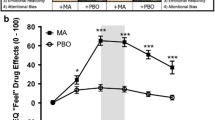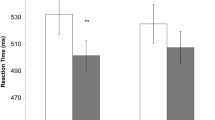Abstract
Seventeen normal, healthy adults were trained to discriminate between orally administered d-amphetamine (AMP; 10 mg) and placebo. Standardized subjective effects questionnaires were used to examine the relationship between the subjective and discriminative stimulus effects of AMP. Seven of the subjects were able to learn the discrimination reliably. These seven “discriminators” did not differ from the ten “nondiscriminators” in their subjective ratings of mood in the absence of drug. Discriminators were generally more sensitive than nondiscriminators to the subjective effects of AMP, although this difference in sensitivity reached statistical significance only for ratings of “hungry.” Stimulus substituion was tested in the discriminators with other doses of AMP (2.5 and 5 mg) and with 10 mg diazepam. The discriminative stimulus properties of AMP were dose-dependent, with 5 mg being the threshold dose. In five of the seven subjects the discriminative stimulus properties of diazepam did not substitute for those of AMP. The results demonstrate that the experimental paradigm can be used successfully to study the discriminative stimulus properties of drugs directly in humans.
Similar content being viewed by others
References
Altman JL, Albert J-M, Milstein SL, Greenberg I (1977) Drugs as discriminable events in humans. In: Lal H (ed) Discriminative stimulus properties of drugs. Plenum, New York, pp 187–206
Barry H (1974) Classification of drugs according to their discriminable effects in rats. Fed Proc 33:1814–1824
Chait LD, Uhlenhuth EH, Johanson CE (1984) An experimental paradigm for studying the discriminative stimulus properties of drugs in humans. Psychopharmacology 82:272–274
Colpaert FC, Rosecrans JA (eds) (1978) Stimulus properties of drugs: Ten years of progress. Elsevier, Amsterdam
Colpaert FC, Slangen JL (eds) (1982) Drug discrimination: Applications in CNS pharmacology. Elsevier, Amsterdam
de Wit H, Johanson CE, Uhlenhuth EH, McCracken S (1983) The effects of two nonpharmacological variables on drug preference in humans. In: Harris LS (ed) Problems of drug dependence, 1982, NIDA Research Monograph 43, Department of Health and Human Services, Rockville, MD, pp 251–257
Dixon WJ (ed) (1983) BMDP statistical software. University of California Press, Berkeley
Haertzen CA (1974) An overview of Addiction Research Center Inventory Scales (ARCI): An appendix and manual of scales. US Government Printing Office, Washington, DC
Ho BT, Richards DW, Chute DL (eds) (1978) Drug discrimination and state-dependent learning. Academic, New York
Jasinski DR (1977) Assessment of the abuse potentiality of morphine-like drugs. In: Martin WR (ed) Handbook of experimental pharmacology. Springer, Heidelberg, pp 197–258
Johanson CE, Uhlenhuth EH (1980a) Drug preference and mood in humans: d-Amphetamine. Psychopharmacology 71:275–279
Johanson CE, Uhlenhuth EH (1980b) Drug preference and mood in humans: Diazepam. Psychopharmacology 71:269–273
Johanson CE, Uhlenhuth EH (1981) Drug preference and mood in humans: Repeated assessment of d-amphetamine. Pharmacol Biochem Behav 14:159–163
Johanson CE, Kilgore K, Uhlenhuth EH (1983) Assessment of dependence potential of drugs in humans using multiple indices. Psychopharmacology 81:144–149
Kallman WM, Kallman MJ, Harry GJ, Woodson PP, Rosecrans JA (1982) Nicotine as a discriminative stimulus in human subjects. In: Colpaert FC, Slangen JL (eds) Drug discrimination: Applications in CNS pharmacology. Elsevier, Amsterdam, pp 211–218
Lal H (ed) (1977) Discriminative stimulus properties of drugs. Plenum, New York
Martin WR, Sloan JW, Sapira JD, Jasinski DR (1971) Physiologic, subjective, and behavioral effects of amphetamine, methamphetamine, ephedrine, phenmetrazine, and methylphenidate in man. Clin Pharmacol Ther 12:245–258
McNair DM, Lorr M, Droppleman LF (1971) Manual for the Profile of Mood States. Educational and Industrial Testing Service, San Diego
Schuster CR, Balster RL (1977) The discriminative stimulus properties of drugs. In: Thompson T, Dews PB (eds) Advances in behavioral pharmacology, vol 1. Academic, New York, pp 85–138
Author information
Authors and Affiliations
Rights and permissions
About this article
Cite this article
Chait, L.D., Uhlenhuth, E.H. & Johanson, C.E. The discriminative stimulus and subjective effects of d-amphetamine in humans. Psychopharmacology 86, 307–312 (1985). https://doi.org/10.1007/BF00432219
Received:
Accepted:
Issue Date:
DOI: https://doi.org/10.1007/BF00432219




